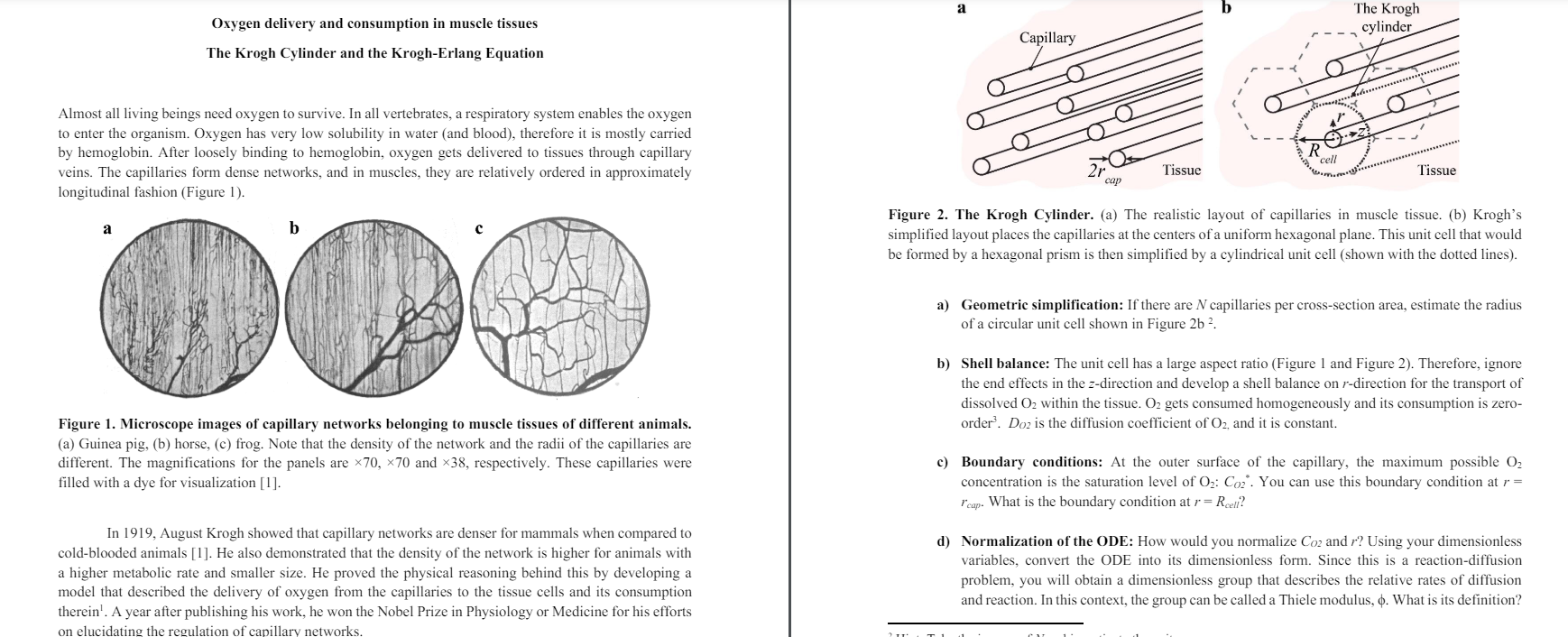Answered step by step
Verified Expert Solution
Question
1 Approved Answer
Oxygen delivery and consumption in muscle tissues The Krogh Cylinder and the Krogh - Erlang Equation Almost all living beings need oxygen to survive. In
Oxygen delivery and consumption in muscle tissues The Krogh Cylinder and the KroghErlang Equation Almost all living beings need oxygen to survive. In all vertebrates, a respiratory system enables the oxygen to enter the organism. Oxygen has very low solubility in water and blood therefore it is mostly carried
by hemoglobin. After loosely binding to hemoglobin, oxygen gets delivered to tissues through capillary veins. The capillari In August Krogh showed that capillary networks are denser for mammals when compared to coldblooded animals He also demonstrated that the density of the network is higher for animals with a higher metabolic rate and smaller size. He proved the physical reasoning behind this by developing a model that described the delivery of oxygen from the capillaries to the tissue cells and its consumption therein. A year after publishing his work, he won the Nobel Prize in Physiology or Medicine for his efforts on elucidating the regulation of capillary networks. In this active session, more than years later, we will analyze Kroghs model on oxygen diffusion and consumption in tissues, which is a classic reactiondiffusion problem. Our goal to is to obtain an estimate of the concentration profile of dissolved oxygen within muscle tissue and analyze its consequences. Krogh had a brilliant perspective for modelling the capillary network and the tissue encapsulating it He visualized the network as a regular array of capillaries, each placed at the center of a close packed hexagonal unit cell Figure a and b Then, he approximated the unit cell with a cylinder, so that the problem was amenable to analytical analysis.. This unit cell that would be formed by a hexagonal prism is then simplified by a cylindrical unit cell. a Geometric simplification: If there are N capillaries per crosssection area, estimate the radius of a circular unit cell shown in Figure b b Shell balance: The unit cell has a large aspect ratio Figure and Figure Therefore, ignore the end effects in the zdirection and develop a shell balance on rdirection for the transport of dissolved O within the tissue. O gets consumed homogeneously and its consumption is zeroorder. DO is the diffusion coefficient of O and it is constant.
c Boundary conditions: At the outer surface of the capillary, the maximum possible O concentration is the saturation level of O: CO You can use this boundary condition at r rcap. What is the boundary condition at r Rcell?
d Normalization of the ODE: How would you normalize CO and r Using your dimensionless variables, convert the ODE into its dimensionless form. Since this is a reactiondiffusion problem, you will obtain a dimensionless group that describes the relative rates of diffusion and reaction. In this context, the group can be called a Thiele modulus, What is its definition? e Normalization of the BCs: What are the boundary conditions for the dimensionless variables? Use kappa rcapRcell
f The solution: Solve the differential equation.
g Critical value of : crit Note that if is larger than a certain value, O will not reach to the boundary of the unit cell. In that case, an oxygenstarved, aka anoxic, region will develop. In a few minutes, the anoxic cells will die. This is called necrosis. Develop an expression for crit
h The meaning of kappa Go back to the definition of Rcell and show that kappa is equal to alpha cap, which is the areal density of capillaries. That isalpha cap total crosssection area of all capillariestotal crosssection area of the tissue Write crit in terms of alpha cap instead of kappa
i Critical rate constant, kcrit. The zeroorder rate constant is representative of the metabolic rate. In conjunction with the result of part h for crit use the definition of that you obtained after normalization and obtain an expression for the maximum O consumption rate. This value is related to the maximum metabolic rate allowable before an anoxic region develops.
j Trends. Go back to the definition of that you obtained after normalization and replace Rcell with N Near crit levels, necrosis occurs if any of the following occurs.
Presence of tumor cells
Faulty capillaries
Low levels of O saturation in blood
Identify which parameter in the definition of changes for the cases given above. Does the parameter increase or decrease?
k Calculating crit For the muscle tissue of a horse, N mm
and rcap mu m Calculate Rcell and crit Do the same for a frog tissue: N mm and rcap mu m
l The Krogh length, Lambda Note that for the different tissues in part kcrit ~ Using the definition of derive a length scale that approximately characterizes the maximum distance between the capillaries. For similar CO
and DO note that the distance Lambda is determined by the metabolic
rate only, as Krogh showed experimentally.

Step by Step Solution
There are 3 Steps involved in it
Step: 1

Get Instant Access to Expert-Tailored Solutions
See step-by-step solutions with expert insights and AI powered tools for academic success
Step: 2

Step: 3

Ace Your Homework with AI
Get the answers you need in no time with our AI-driven, step-by-step assistance
Get Started


